Everything you need to know about underfloor heating
What material for underfloor heating?
Before we proceed to the purchase of components for the target installation, we face a dilemma, what material for underfloor heating will work best in a given room. After all, the floor must meet a number of technical criteria: resistance to higher temperatures, excellent thermal conductivity parameters, low abrasion class of the outer coating. Let's choose only those products that provide a low R index. Under this letter there is a thermal resistance coefficient that has a direct impact on the efficiency and energy efficiency of the entire system. Even the best heating mats they're useless if they're wrong material for underfloor heating will effectively sabotage their work. Our goal should be the lowest possible R value in the product specification. It should be clearly noted that the R factor is cumulative. The calculations refer to the sum of R for the floor and underlay. EU standards set the upper limit of this value at 0.15 m²K/W, which has its roots in reducing energy consumption. Optimal thermal resistance parameters improve the performance of the mat system heating cables . Natural stone, panels, tiles, wooden parquet, carpet - what to choose for floor finishing? The lowest thermal resistance values can be attributed to ceramic and stone tiles. These are extremely effective materials for the floor, which can be used both in rooms with increased humidity (kitchen, bathroom), as well as in the living room or bedroom. Ceramic tiles turn out to be slightly cheaper than their stone counterparts. However, they maintain excellent heat conduction properties. We recommend them for houses with large areas, where cost reduction is one of the priorities of the interior finishing process. Since a ceramic or stone floor finish meets the needs of most investors, what about the other options? Some people consider covering the floor with heating mats with a carpet. While it is hard to deny the comfort and cosiness of such a solution, the structure of the carpet becomes a layer of additional insulation. The heat generated by the floor installation will not be able to penetrate into the room and raise the temperature efficiently. Thin polypropylene linings are an interesting option. Thermal conductivity disturbances remain at a minimum level here.
If we are thinking about wood, we should carefully read the information from the manufacturer. The decision which material for the floor will provide the expected functions must result from the analysis of the thermal resistance coefficient. Exotic wood, although more expensive, will be better for users of heating mats. Its low shrinkage and resistance to frequent temperature changes make the parquet made of iroko or teak wood last for many years.
What panels for underfloor heating ?
The quality of the underlay has a huge impact on the efficiency of the installation. When installing floor panels on the accumulation system, a special underlay should be used, which will not be a heat insulator. In our analysis of materials for floor insulation, the panels deserve a separate mention. The low price and ease of assembly have won them many supporters, and their manufacturers adapt their products to the expectations of users. What panels for underfloor heating worth considering?
There are two types of products that we can particularly recommend: laminate and vinyl. Vinyl flooring costs more but provides a thermal resistance R of approximately 0.020 m2*K/W. It's an excellent result. The small thickness of the vinyl plank and the convenient system of latches on the one hand facilitate the distribution of heat around the rooms, and on the other - increase the resistance to usable distortions.
If you want to maximize the benefits, choose SPC panels with a hard core. Pay attention to the class of use of vinyl models. We suggest purchasing solutions with class 23 or higher.
Contact specialists who will tell you what underlayment for underfloor heating panels will prove to be the best in your situation.
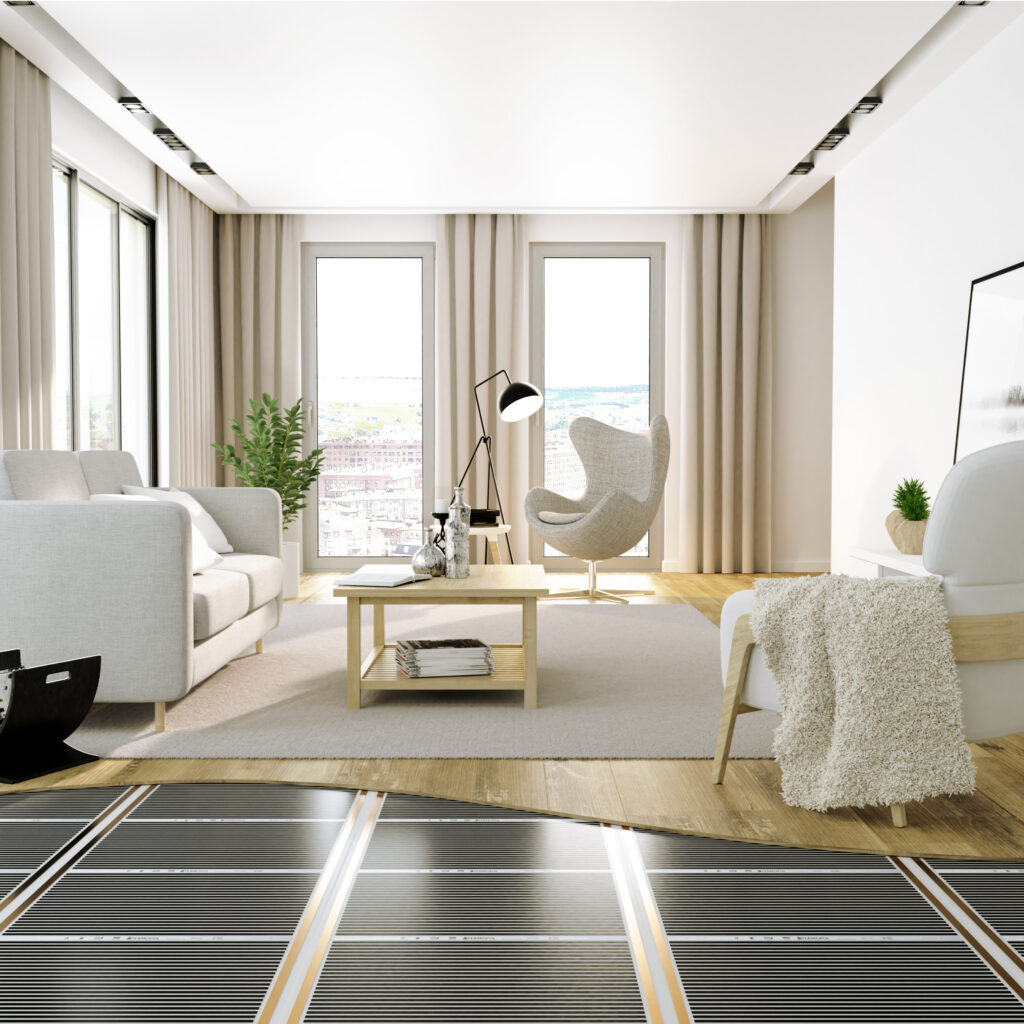
How to prepare the substrate for underfloor heating ?
Before we start spreading the heating mat or heating cables on a given surface, it is necessary to carry out the previous steps to ensure proper operation of the installation. Preparation of the substrate for underfloor heating consists in leveling, smoothing and cleaning it. At this stage, the future user makes a number of technical decisions regarding the thickness of the screed and the arrangement of electrical wires in the wall. An extremely important step is to make a hole for the installation box and determine the installation location of the floor temperature sensor. We must also consider the technology of building thermal insulation in the floor. About that, what polystyrene under floor heating it is worth using in a house or apartment, we will tell you more later in the text. In addition to the insulating material, investors can choose a substrate made of extruded polystyrene or mineral wool. Polyisocyanurate (PIR) foam is also a great insulator. Let's remember that substrate for underfloor heating it must provide the expected resistance to overloads and frequent temperature fluctuations. These features result from the structure of the insulating material and the cross-section of the layer. The floor location parameters in a given room are used to determine the thickness. If it is located directly on the ground, then it is better to slightly oversize the thickness of the insulation. For ceilings above heated rooms, this value oscillates around 5 cm. We recommend installing insulation boards in a mixed arrangement. This means that the joints of the boards of the first layer of insulation should not coincide with the joints of the boards of the next layer. Condensed gaps in the insulating material would have the undesirable function of a thermal bridge and would reduce the performance of the heating cables.What is the thickness of the screed?
The installation of heating cables under the spout has a deep practical justification. This modern technique of installing electric underfloor heating resembles the operation of a storage heater. The heat spreads evenly throughout the rooms and is characterized by high inertia. In contrast to the water version, electric heating enables a significant acceleration of the first stage of the whole process. Sealing the heat in the floor causes its long-term return to the interior. Thanks to this, the user gains the opportunity to reduce energy bills. There is a lot of information about screeds for heating cables. The experience of most users leads to an unequivocal recommendation. With electric underfloor heating, anhydrite screeds, also known as self-levelling, work best. In addition to the unquestionable convenience of application and perfect smoothness, this type of substrate has another key advantage - excellent heat conduction. In order to fully enjoy the proven benefits of an anhydrite screed, a decision must be made on the scale of coverage on the insulating material. What thickness of screed for underfloor heating turns out to be optimal? The technological process here resembles a compromise between thermal resistance and overload resistance. A layer of about 7 cm seems to be the golden mean in this matter. In the case of less frequented rooms, it can be reduced to 4-5 cm.What polystyrene for underfloor heating ?
Traditional facade polystyrene does not meet the stringent quality criteria for systems consisting of heating cables in the floor. The problem lies in its too low compressive strength. Knowledge, how to prepare the substrate for underfloor heating includes a number of guidelines for polystyrene boards. The optimal insulation is hard polystyrene, referred to as EPS100, EPS150 or EPS200. The higher the value, the lower the susceptibility to overload deformation. For home use, EPS100 polystyrene is sufficient. The roof-floor polystyrene substrate adopts one more component for its specification. We are talking about the lambda coefficient, which refers to the degree of heat conduction. The lower the lambda, the better the insulation parameters. It's not worth saving on styrofoam. The investment in the best quality product pays off in the course of subsequent operation.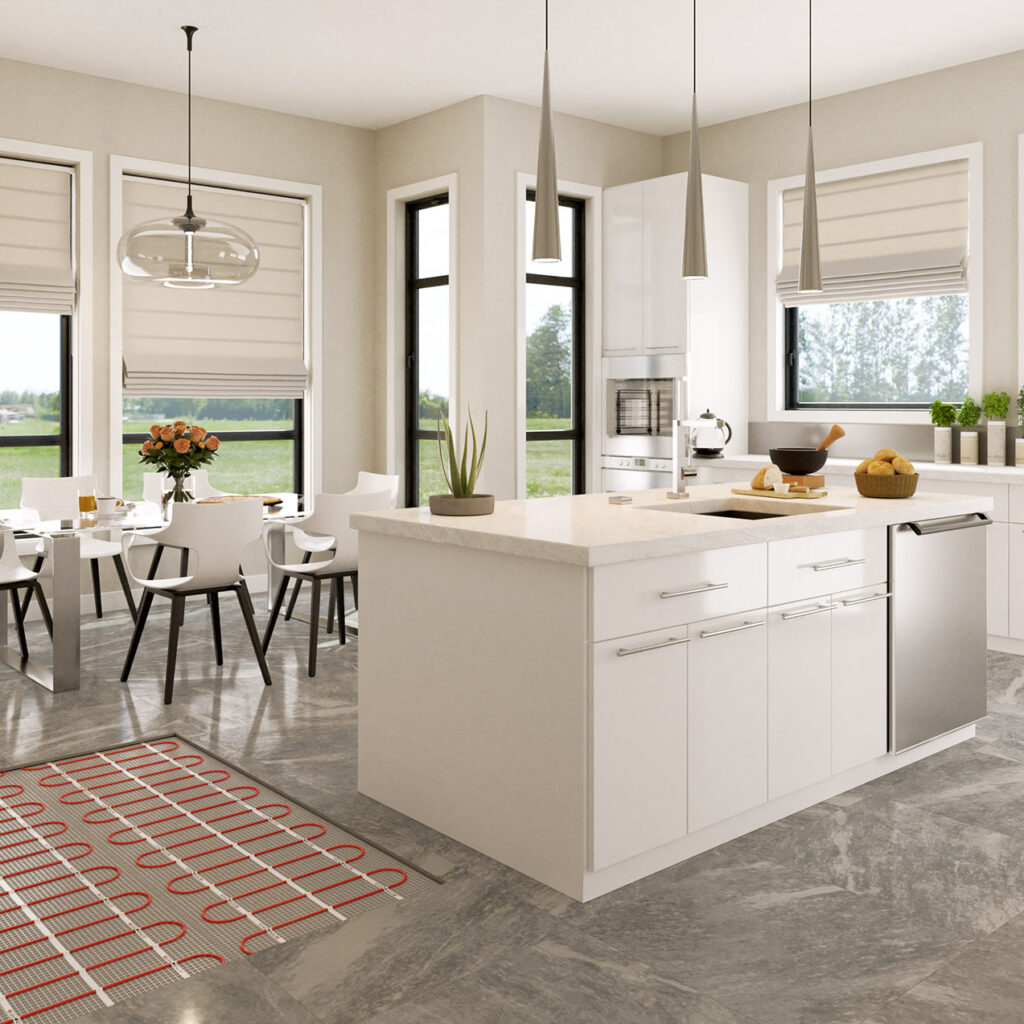
Underfloor heating diagram - where and how should they be placed?
One of the advantages of electric heating cables is the ease of their installation. Uncomplicated installation steps result in reduced labor costs and faster commissioning of the heating system. There are a few rules to keep in mind when laying individual sections of wiring. First of all, under no circumstances do not cut the wires . Before installing the system, its power must be properly selected. This will optimize the heating time. It is necessary to mark the places where permanent buildings will be built in the future, because these places should be avoided when laying cables. cables We never place heating cables under objects such as a wardrobe, fridge or washing machine, unless the cables are placed on the foundation plate. Then the cables are covered with a thick layer of concrete. Before we start laying the underfloor heating , it is better to submit the scheme to specialists for evaluation. The future performance of the floor heating cable system depends on the complexity and accuracy of the design. Energy-saving technologies need the right conditions to work. If we do not provide them with an environment in accordance with the manufacturer's recommendations, floor tiles may lose their attractiveness. The scheme of laying the floor in the living room, kitchen or bathrooms is the basic document for the investor and the construction team. It allows you to better visualize the entire installation and make well-thought-out adjustments depending on changing conditions. Read on and you will learn more about how to install underfloor heating in the living room and other rooms.Kitchen
You may ask yourself whether underfloor heating in the kitchen makes sense? Is it better to reduce costs and redirect funds for the purchase and installation of heating cables for more rooms? Nothing could be more wrong. After all, we do most of our daily and evening activities in the kitchen. The assembly rules we mentioned at the very beginning also apply to the kitchen space. Finishing the floor with ceramic or stone tiles perfectly harmonizes with modern mats and heating cables , enabling them to work at full capacity. The installation scheme should take into account the layout of the kitchen equipment and avoid placing the system directly under the furniture and the refrigerator. Heating in this room contributes to a significant improvement in thermal comfort in the winter season. At the same time, it is safe for people struggling with allergies and respiratory diseases. Installation of the system in the kitchen can be planned already at the stage of erecting the building. However, nothing stands in the way of the floor gaining new functionality during renovation in an older property. Installing electric mats under kitchen tiles guarantees long-term benefits of an energy-saving and efficient temperature control system.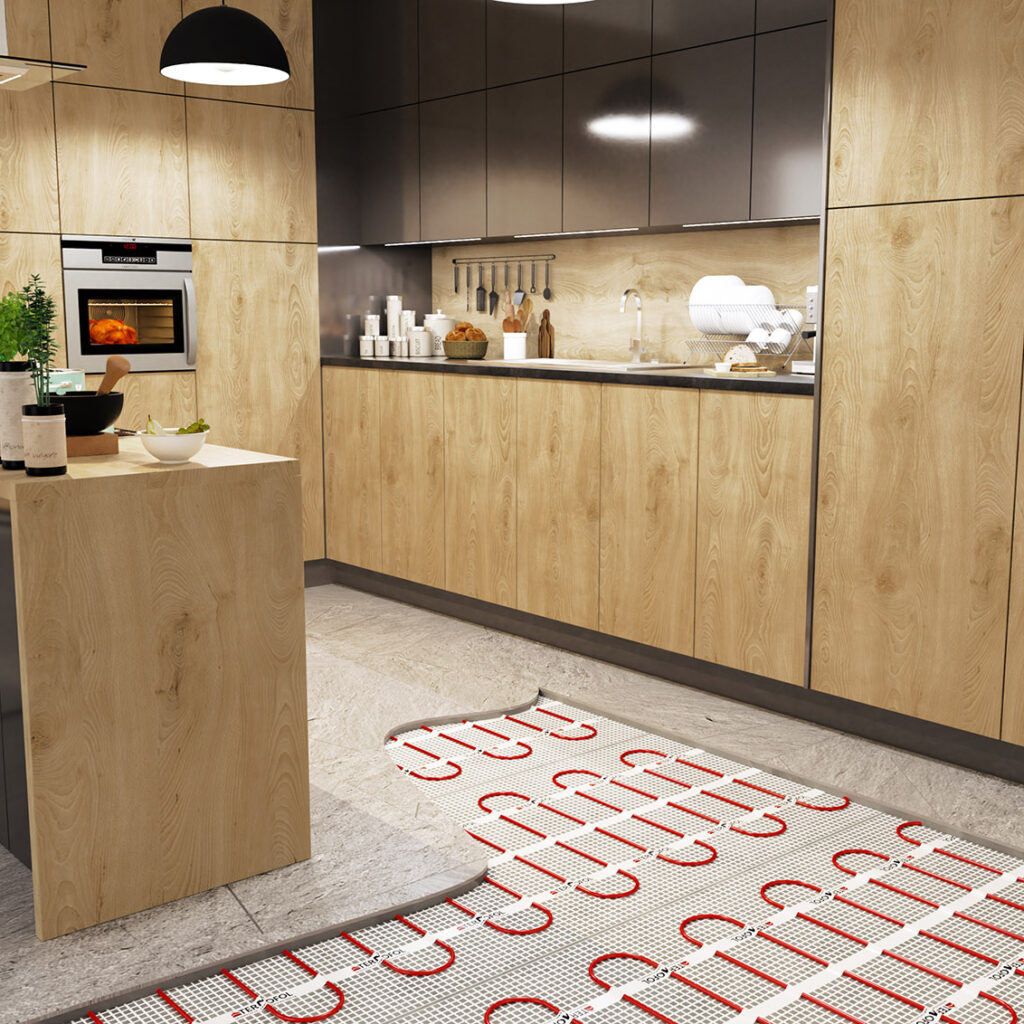
Bathroom
The modular nature of heating mats i of heating cables fits perfectly into the difficult conditions of the bathroom space. Limited space free from development is not a challenge here. Electric heating components placed on anhydrite screed and covered with tiles provide unsurpassed comfort for residents. To underfloor heating in bathrooms worked at maximum efficiency, it is worth carrying out a floor finish with a material with good conductivity parameters. Materials made of gres, terracotta or natural stone are great for the bathroom.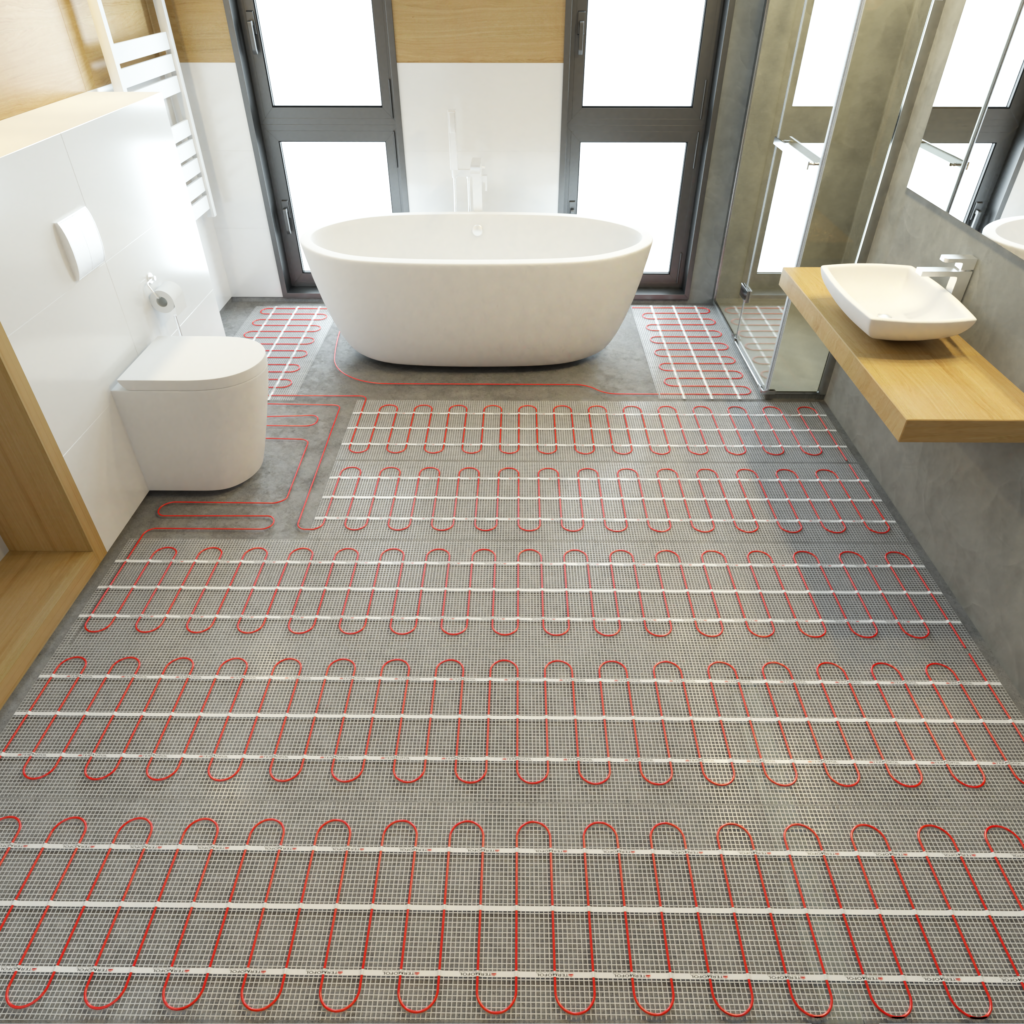
Living room
The installation of electric mats in large rooms is probably the most practical justification. When installing heating cables, it is worth keeping a distance from each wall – 10 cm should be enough. Of course, the rules discussed earlier also apply here. For the floor in the living room, it is worth considering finishing with vinyl panels. A wide range of colors and patterns (combined with low thermal resistance) make this type of product an optimal solution for electric heating systems. The floor in the living room with underfloor heating becomes extremely comfortable. It is an ideal solution for families with children and people struggling with periodic upper respiratory tract infections. Insulating the parquet floor in the living room with efficient mats is valued for failure-free operation, lack of maintenance requirements, thermal efficiency and energy savings.Room
The thermostat is the heart of an electric heating installation. It is responsible for interpreting the data coming from the sensors and controlling the heating parameters depending on the prevailing conditions. Floor heating in the rooms should be planned with particular consideration of heat demand. Automation of settings translates into savings and allows you to obtain the required thermal comfort.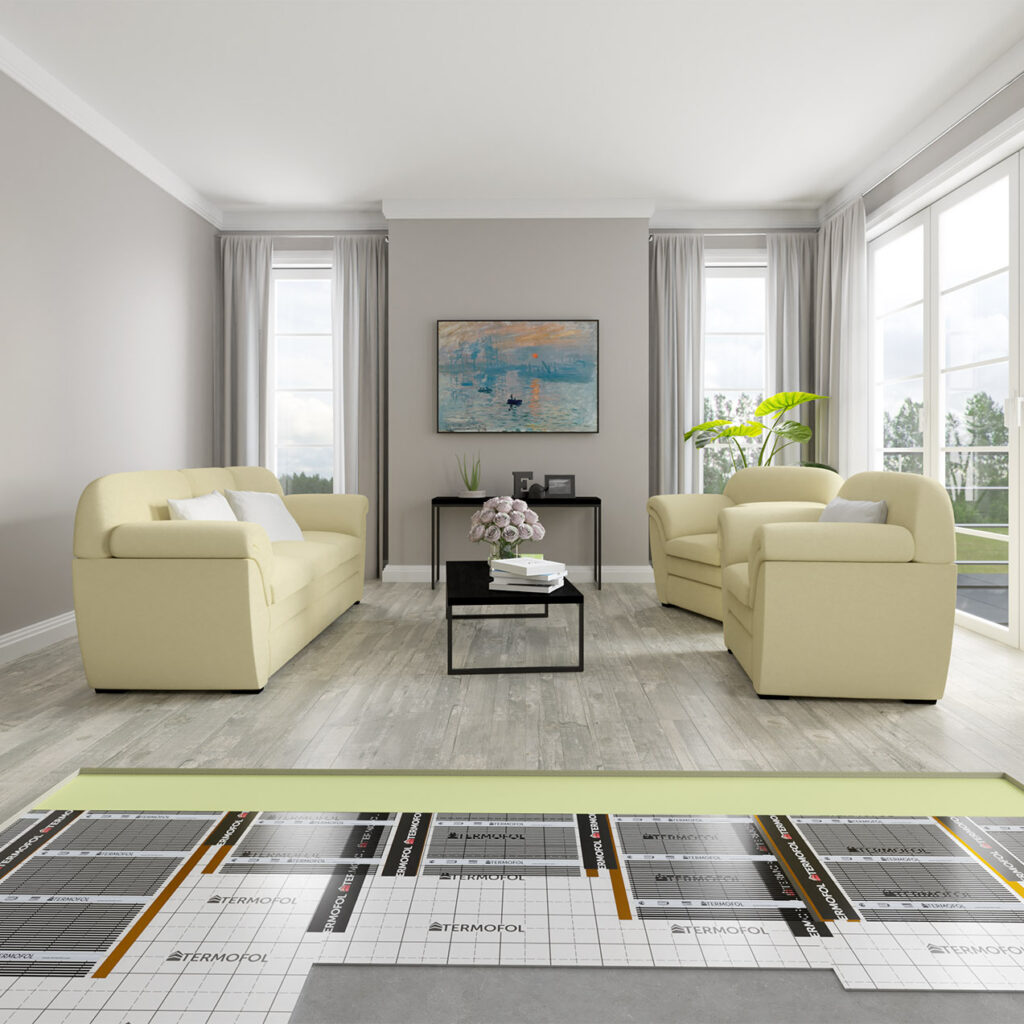
How much does underfloor heating cost ?
There is no doubt that the installation of underfloor heating systems in the electric version entails certain initial costs. However, the investment is deeply justified and results in improved everyday comfort for residents. Therefore how much does underfloor heating cost ? How are the prices depending on the type of property? As usual with these types of questions, it remains impossible to give a clear answer. The installation of a heating system in a house or apartment determines the value of how many pipes per m2 (or cables or heating films) we will have to buy. The larger the area, the higher the cost of installation, of course. In addition to the electrical wiring itself, the property owner must consider buying a high-performance thermostat. The cost of professional installation must be added to the total cost. Each additional meter of usable area covered with cables or heating foils increases the cost of installation. However, we do not want to leave the reader without specific numbers. Planning your expenses before making purchasing decisions is a key step. So let's take the market average. As our experience as a manufacturer of heating foils and underfloor heating mats shows, the estimated investment costs range from PLN 100-250 per square meter. The ranges quoted here assume the complexity of the process and include all expenses prior to launching the underfloor heating system. If you want to know exactly How much does it cost to install underfloor heating in your property, contact with us . After presenting specific data on the location and power of the system, specialists will be able to develop a personalized cost estimate.The cost of installing heating in the house and apartment
The discussed heating technology enables installation during the erection of a new building body and during renovation works in real estate from the secondary market. Therefore, it seems reasonable to ask about the cost of installing underfloor heating in a house and an apartment . Will we meet with far-reaching differences here? The good news for investors is that, in principle, it does not matter where we install the heating system. The mere fact of installing a heating system in a single-family house or apartment does not increase the price of one square meter of the system. Of course, the larger the area to be covered, the more the total cost increases. However, this how much does a meter of underfloor heating cost, results primarily from the quality of components and the degree of complexity of assembly, and not the nature of the location itself. Manufacturers of heating devices offer attractive discounts for the largest investors. Ordering a large amount of heating mats may slightly change the answer to the question, how much does it cost to install underfloor heating in a house . It is worth undertaking individual negotiations and taking advantage of periodic promotions. The reduction of the final price is also enabled by large-scale government subsidy programs.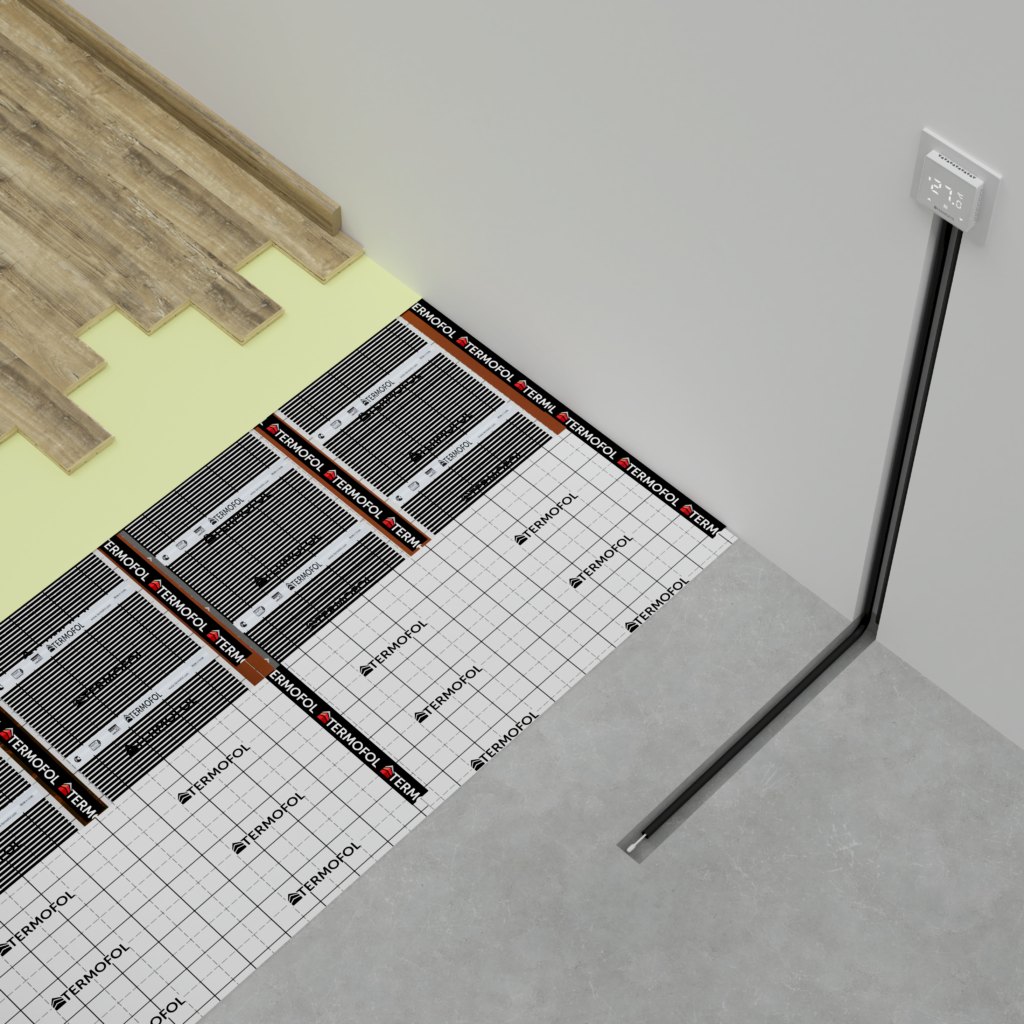
How many pipes per m2 of underfloor heating ?
In our guide, we focus on electrical systems that rely on efficient and energy-saving resistance cables. This, how many pipes per m2 of underfloor heating will be needed, concerns traditional water systems, which are becoming obsolete more and more quickly. Final decisions as to the amount of heating material needed result from the installation diagram. The project should provide for the future location of the equipment and show the optimal distribution of heating pipes in the house or apartment.Floor heating control
Behind floor heating control electrical corresponds specialized thermostat connected to a sensor mounted in the floor. The adjustment of the amount of heat takes place in full accordance with the settings entered by the users. Modern thermoregulators have a built-in air temperature sensor. In addition, they control the floor temperature through an external floor sensor. This eliminates the possibility of overheating the floor. The intervention of the investor is limited to setting the operating mode and determining the heating power. The development of the smart home idea has contributed to the increased interest in wireless solutions. Wi-Fi technology has spread to smart home furnishings and centralized management systems. Installation wires are slowly being replaced by a dedicated mobile application. Thanks to it, users gain complete control over the operation of the heating system from anywhere in the world, without the need to be physically present in the apartment.Wireless control of underfloor heating
The magic of wireless systems lies in unsurpassed convenience and flexibility. Remote control of electric underfloor heating guarantees greater energy savings. Heating only works when it is actually needed. Residents can increase the heating power just before returning from work to enjoy pleasant warmth. At the same time, when the household members are away from the property, it is worth turning off the system and reducing energy consumption. Home automation devices are a prerequisite for proper wireless floor heating control . Individual modules are responsible for maintaining the set temperature in the rooms. It is possible to change the temperature parameters depending on your preferences. Taking into account the individual needs of people in the household is one of the reasons for the widespread recognition of modern heating systems. For example, reducing the heating power in the kitchen has practical justification. Food preparation activities generate additional heat, which must be taken into account in energy calculations. Reducing the target temperature on the thermostat by 2-3 degrees Celsius will noticeably affect the amount of bills. Thanks to this, savings can be redirected to improving the comfort in the bathroom space. Here, heating with electric mats should keep the air temperature at around 23 degrees. A zonal heating installation in a single-family house takes full advantage of the achievements of IoT (Internet of Things) technology. Wireless control based on Wi-Fi gives the whole thing an additional functional dimension and accelerates the return on investment. We encourage you to purchase a Wi-Fi thermostat and gain access to the full functionality of the described mats.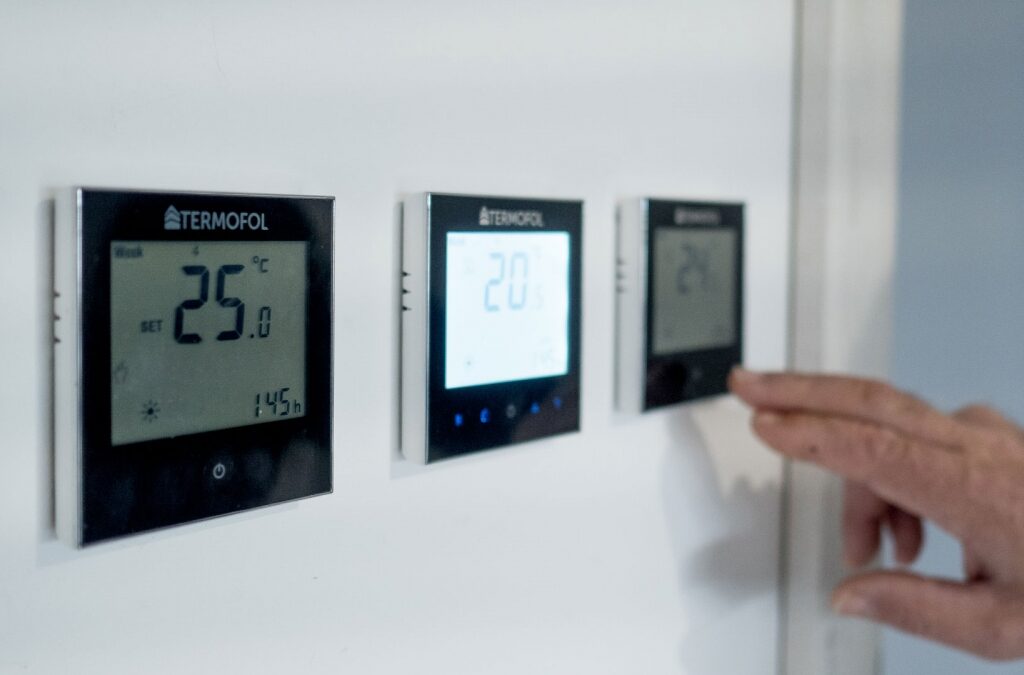
Underfloor heating control kit
The wireless system turns out to be a great idea for the arrangement of heating mats in properties undergoing thermal modernization. The need to drill numerous holes in the wall to route the control cables significantly increases the investment cost. Meanwhile floor heating control Wi-Fi completely eliminates the requirement to assemble a complex cable network. Contact us and learn about proven solutions for residential construction. Complete Wi-Fi systems for managing the operation of heating systems guarantee comfort and safety during many years of operation. A natural feature of the zoning system is also flexibility and reduction of energy consumption costs, i.e. features of fundamental importance for every home owner.How to vent underfloor heating ?
The uniform distribution of heating pipes is, as a rule, to guarantee uniform heating of the entire surface. If this is not the case, specific corrective actions must be taken. It is worth noting that the question posed in the title of this chapter applies only to traditional water systems. It is difficult to suspect that electric heating systems have air in them... Heating cables offer thermal stability throughout the long-term operation cycle and relieve investors from burdensome maintenance activities. Safety, efficiency and maintenance-free operation are some of the main factors that have made electric solutions so popular. However, due to frequently asked questions from users of water systems, we will provide some tips here, how to vent underfloor heating in the apartment. All new water systems should have an automatic air vent valve. If you find disturbances in the heat transfer through the floor, go to the location of the manifold and follow the standard procedure to remove air from the pipes. The first step is to lock all valves in the return beam. Then we open a single valve for selective venting. We realize that for complex installations such activities take some time. This is another reason to seriously consider assembly electric heating system at the next renovation. In the next step, we need to open the water flow in each loop until the air bubbles are completely removed. Only now can we proceed to closing the given valve and repeating the whole process for the next loops. Transferring water in the installation takes up to several minutes (for a single loop). However, it is an effective method for venting the system on the same floor. But what if the manifold is at a lower level than the piping system? How to bleed an underfloor heating system in a multi-story building? It is worth noting that the method described earlier will not work at all. Air is unable to move down the system. Therefore, here the operation should be carried out through a special pump for venting systems or pouring by draining the water into the sewage system and supplementing it with a new fluid, while venting each single loop. The level of complexity increases in direct proportion to the complexity of the heating system. With a large number of rooms located on several floors, it sometimes takes a whole day to remove air from the pipes. It is worth considering the causes of air getting inside. Venting will do nothing if the source of the problem is a hidden defect in the water system. In some situations, the support of the service team will be unavoidable, which naturally leads to increased operating costs.How to effectively vent the underfloor heating system?
We advise against excessive haste and the resulting inaccuracy. Attempts to bleed the underfloor heating system give rise to a substantial dose of understandable frustration. Therefore, we strongly encourage new investors to change their approach and turn to electric floorboards . Its advantages fully compensate for the expenses incurred. The mats generate savings on repair and service activities, which remain a common problem for users of water floor systems. Instead of wondering how to bleed the underfloor heating system , sleep better and enjoy maintenance-free electric heating.Is underfloor heating healthy ?
Heating mats have established their position on the market and confirmed their effectiveness. Despite this, there are still many myths about their effectiveness and functionality on the Internet. Health issues also raise many questions. Is underfloor heating healthy ? Is it suitable for families with children or people with diagnosed allergies or respiratory diseases? Scientific research clearly proves the positive impact of electric floor heating on the health of users. Why is this happening? Well, the heating cables are evenly distributed in the room. This arrangement creates a kind of large-area radiator that evenly gives off heat. The heat energy spreads from the floor to the ceiling. The heated air in the lower part of the room improves circulation. However, already at the level of the chest of an adult person, the temperature becomes noticeably lower, which reduces the phenomenon of drying the mucous membrane of the throat and nose. Maintaining humidity at a higher level is also a beneficial side effect of the temperature distribution in rooms with mats. Traditional radiators tend to dehumidify the air quickly. The winter season is a hard time for the respiratory system. Floor heating reduces ailments resulting from the heating period and creates a healthy environment in the apartment. One of the most important advantages attributed to heating with mats and electric cables is also the reduction of floating household dust. How is this possible? Radiators placed on the wall offer a small heating surface. In order to heat a room in a reasonable amount of time, they have to heat themselves to a high temperature. This, in turn, causes increased air circulation and the rising of dust from the floor. The ubiquitous dust particles contain many substances that have an irritating effect on the nasal mucosa. Meanwhile, underfloor heating significantly reduces this unfavorable phenomenon. The floor becomes an extensive heating plate, which provides thermal comfort and limits the movement of loose particles of matter.
Scientific research clearly proves the positive impact of electric floor heating on the health of users. Why is this happening? Well, the heating cables are evenly distributed in the room. This arrangement creates a kind of large-area radiator that evenly gives off heat. The heat energy spreads from the floor to the ceiling. The heated air in the lower part of the room improves circulation. However, already at the level of the chest of an adult person, the temperature becomes noticeably lower, which reduces the phenomenon of drying the mucous membrane of the throat and nose. Maintaining humidity at a higher level is also a beneficial side effect of the temperature distribution in rooms with mats. Traditional radiators tend to dehumidify the air quickly. The winter season is a hard time for the respiratory system. Floor heating reduces ailments resulting from the heating period and creates a healthy environment in the apartment. One of the most important advantages attributed to heating with mats and electric cables is also the reduction of floating household dust. How is this possible? Radiators placed on the wall offer a small heating surface. In order to heat a room in a reasonable amount of time, they have to heat themselves to a high temperature. This, in turn, causes increased air circulation and the rising of dust from the floor. The ubiquitous dust particles contain many substances that have an irritating effect on the nasal mucosa. Meanwhile, underfloor heating significantly reduces this unfavorable phenomenon. The floor becomes an extensive heating plate, which provides thermal comfort and limits the movement of loose particles of matter.
Is underfloor heating recommended for allergy sufferers?
An electric heating system in the floor helps to reduce the symptoms of allergies, asthma or chronic cough. Keeping dust and mites in check is one of the most important conditions for people affected by various respiratory diseases. Among all heating systems in modern construction, floor heating is distinguished by the most favorable health parameters. This is one of the main arguments justifying the investment in heating mats.Will underfloor heating work in the bedroom?
If the budget allows it, we also recommend installing electric mats in bedrooms. In-floor heating not only works great in the bedroom, but also provides the same health benefits that are so important in other rooms. Of course, we do not recommend maintaining the heating power at the same level throughout the day. Remember that the optimal temperature for sleeping is considered to be around 17-19 degrees Celsius. (and here we also have exceptions ;-)) It is worth thinking about automating the settings in the thermostat and determining the hourly schedule for starting the installation.Heating the floor - is it unhealthy?
Heat is transferred from the floor by radiation, not convection (as in the case of radiators). Therefore, the myth about the potential harmfulness of electric heating mats can now be dispelled. Health-promoting properties of heating systems hidden in the floor result from the even distribution of temperature, limiting the drying of the air and minimizing the rising of dust. Both healthy people and people struggling with allergies should be interested in the installation of modern heating solutions with proven health benefits.Summary - is it worth investing in underfloor heating?
We have given a lot of technical information about subfloor preparation, design and functionality of electric heating systems in the floor. It is time to summarize these considerations and consider whether the investment in electric underfloor heating will work in every case. In opposition to wall-mounted or free-standing radiators, the underfloor heating radiates heat over a much larger surface. The principle of operation of mats and heating cables has positive consequences:- energetic,
- financial,
- performance,
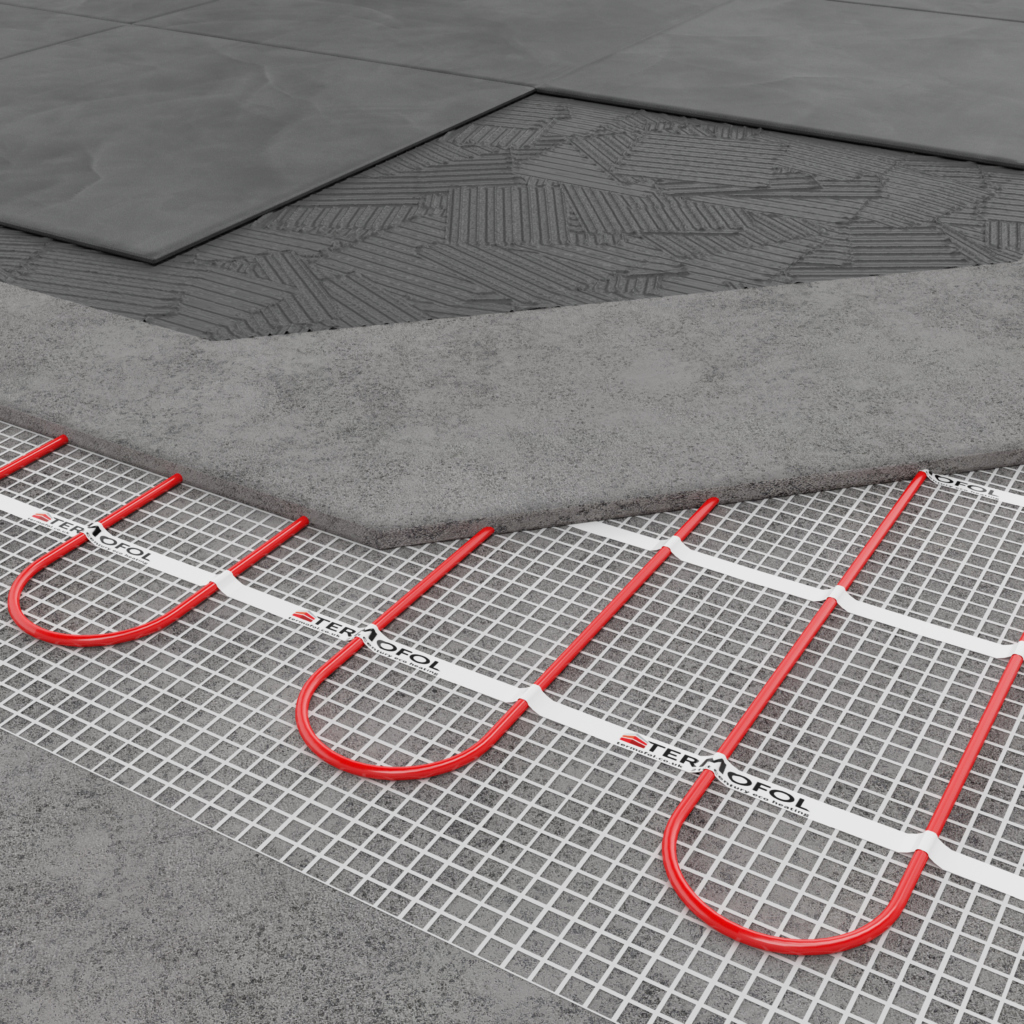 Space saving is also important. The cubic capacity and functionality of the living quarters are significantly affected by the presence of protruding radiators. The place under the sill is blocked, and the shape of traditional heating devices leaves much to be desired in terms of aesthetics. Electrical installation hidden in the floor eliminates such problems. Nothing interferes with the arrangement possibilities, and just moving on a warm floor provides a pleasant feeling (especially in winter).
Space saving is also important. The cubic capacity and functionality of the living quarters are significantly affected by the presence of protruding radiators. The place under the sill is blocked, and the shape of traditional heating devices leaves much to be desired in terms of aesthetics. Electrical installation hidden in the floor eliminates such problems. Nothing interferes with the arrangement possibilities, and just moving on a warm floor provides a pleasant feeling (especially in winter).

